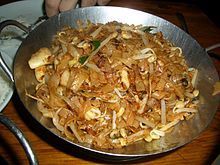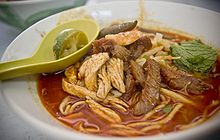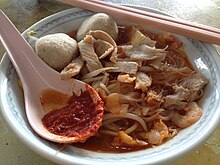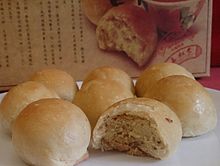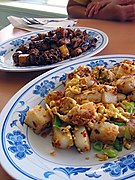
Teochew cuisine, also known as Chiuchow cuisine, Chaozhou cuisine or Teo-swa cuisine, originated from the Chaoshan region in the eastern part of China's Guangdong Province, which includes the cities of Chaozhou, Shantou and Jieyang. Teochew cuisine bears more similarities to that of Fujian cuisine, particularly Southern Min cuisine, due to the similarity of Teochew's and Fujian's culture, language, and their geographic proximity to each other. However, Teochew cuisine is also influenced by Cantonese cuisine in its style and technique.

Malaysian cuisine consists of cooking traditions and practices found in Malaysia, and reflects the multi-ethnic makeup of its population. The vast majority of Malaysia's population can roughly be divided among three major ethnic groups: Malays, Chinese and Indians. The remainder consists of the indigenous peoples of Sabah and Sarawak in East Malaysia, the Orang Asli of Peninsular Malaysia, the Peranakan and Eurasian creole communities, as well as a significant number of foreign workers and expatriates.

Hokkien mee, literally "Fujian noodles", is a series of related Southeast Asian dishes that have their origins in the cuisine of China's Fujian (Hokkien) province.

Singaporean cuisine is derived from several ethnic groups in Singapore and has developed through centuries of political, economic, and social changes in the cosmopolitan city-state.

Banmian or pan mee is a popular Chinese noodle dish, consisting of handmade noodles served in soup. Other types of handmade noodles include youmian, or mee hoon kueh.

Penang cuisine is the cuisine of the multicultural society of Penang, Malaysia. Most of these cuisine are sold at road-side stalls, known as "hawker food" and colloquially as "muckan carts". Local Penangites typically find these hawker fares cheaper and easier to eat out at due to the ubiquitousness of the hawker stalls and that they are open for much of the day and night. Penang island. On February 22, 2013, Penang was ranked by CNN Travel as one of the top ten street food cities in Asia. Penang has also been voted by Lonely Planet as the top culinary destination in 2014.

Ipoh has a significant food scene with many hawker centres and restaurants. It has dishes derived from Malay, Chinese and Indian cuisine. In recent years, Ipoh has seen an increase in international restaurants, bars and gastropubs which have become popular with locals and tourists.

Noodle soup refers to a variety of soups with noodles and other ingredients served in a light broth. Noodle soup is a common dish across East Asia, Southeast Asia and the Himalayan states of South Asia. Various types of noodles are used, such as rice noodles, wheat noodles and egg noodles.

Curry mee is a Maritime Southeast Asian spicy noodle soup garnished with various toppings. In Johor and Singapore, it is sometimes called curry laksa. Numerous variants of the dish, including preparations with a drier or thicker gravy, exist in both the countries of Malaysia and Singapore.

Chinese Indonesian cuisine is characterized by the mixture of Chinese with local Indonesian style. Chinese Indonesians, mostly descendant of Han ethnic Hokkien and Hakka speakers, brought their legacy of Chinese cuisine, and modified some of the dishes with the addition of Indonesian ingredients, such as kecap manis, palm sugar, peanut sauce, chili, santan and local spices to form a hybrid Chinese-Indonesian cuisine. Some of the dishes and cakes share the same style as in Malaysia and Singapore, known as Nyonya cuisine by the Peranakan.

Rice vermicelli is a thin form of noodle. It is sometimes referred to as "rice noodles" or "rice sticks", but should not be confused with cellophane noodles, a different Asian type of vermicelli made from mung bean starch or rice starch rather than rice grains themselves.

Fried noodles are common throughout East Asia, Southeast Asia and South Asia. Many varieties, cooking styles, and ingredients exist.

Korean Chinese cuisine, also known as Sino–Korean cuisine, is a hybrid cuisine developed by the ethnic Chinese in Korea.

Mee pok is a Chinese noodle characterized by its flat and yellow appearance, varying in thickness and width. The dish is of Chaoshan origin and is commonly served in the Chaoshan region of China and countries with a significant Chaoshan Chinese immigrant population such as Singapore, Malaysia and Thailand. Mee pok is commonly served tossed in a sauce, though sometimes served in a soup. Meat and vegetables are added on top.

Peranakan cuisine or Nyonya cuisine comes from the Peranakans, descendants of early Chinese migrants who settled in Penang, Malacca, Singapore and Indonesia, inter-marrying with local Malays. In Baba Malay, a female Peranakan is known as a nonya, and a male Peranakan is known as a baba. The cuisine combines Chinese, Malay, Javanese, South Indian, and other influences.

Bakmi or bami is a type of wheat based noodles derived from Chinese cooking tradition. It was brought to Indonesia by Chinese immigrants from Southern Chinese provinces like Fujian. It is typically prepared seasoned in soy sauce and topped with pork products, which is often substituted for other protein sources in predominantly Muslim Indonesia. Chinese-style wheat noodles has become one of the most common noodle dishes, especially in Southeast Asian countries which have significant Chinese populations and known by various names.

Char kway teow is a stir-fried rice noodle dish from Maritime Southeast Asia of southern Chinese origin. In Hokkien and Teochew, char means 'stir-fried' and kway teow refers to flat rice noodles. It is made from flat rice noodles or kway teow of approximately 1 cm or about 0.5 cm in width, stir-fried over very high heat with garlic, light and dark soy sauce, chili paste, whole prawns, shelled blood cockles, chopped Chinese chives, slices of Chinese sausage, and bean sprouts. Other common ingredients include fishcake and belachan.

Wonton noodles is a noodle dish of Cantonese origin. Wonton noodles were given their name, húntún, in the Tang Dynasty. The dish is popular in Southern China, Hong Kong, Indonesia, Malaysia, Singapore and Thailand. The dish usually consists of egg noodles served in a hot broth, garnished with leafy vegetables and wonton dumplings. The types of leafy vegetables used are usually gai-lan, also known as Chinese broccoli or Chinese kale. Another type of dumpling known as shui jiao (水餃) is sometimes served in place of wonton. Shrimp wonton are mostly known as Hong Kong dumplings. The wontons contain prawns, chicken or pork, and spring onions, with some chefs adding mushroom and black fungus. In Indonesia especially in North Sumatra, West Kalimantan and South Sulawesi, wonton noodles are called mie pangsit.

Indonesian noodles are a significant aspect of Indonesian cuisine which is itself very diverse. Indonesian cuisine recognizes many types of noodles, with each region of the country often developing its own distinct recipes.
